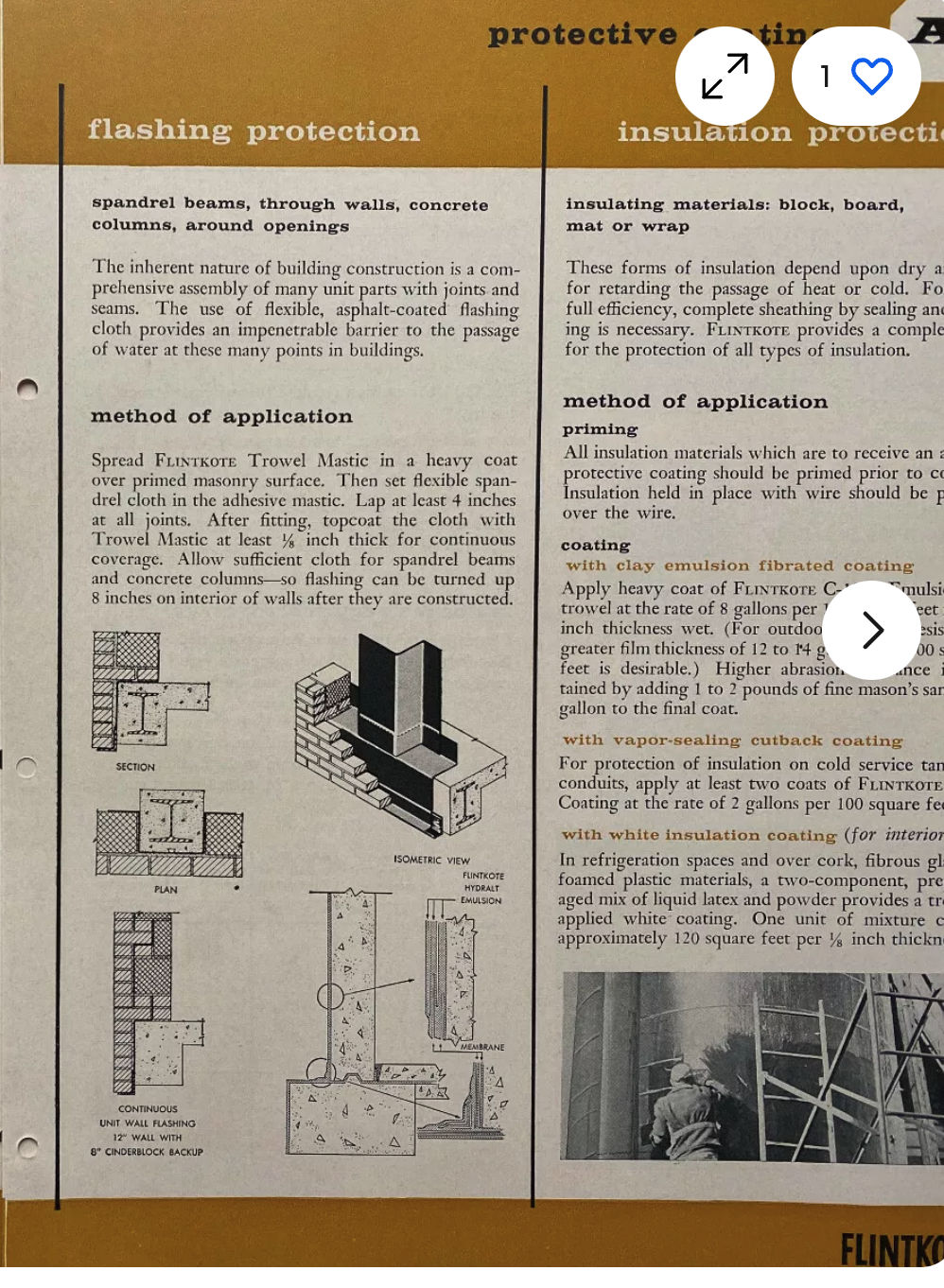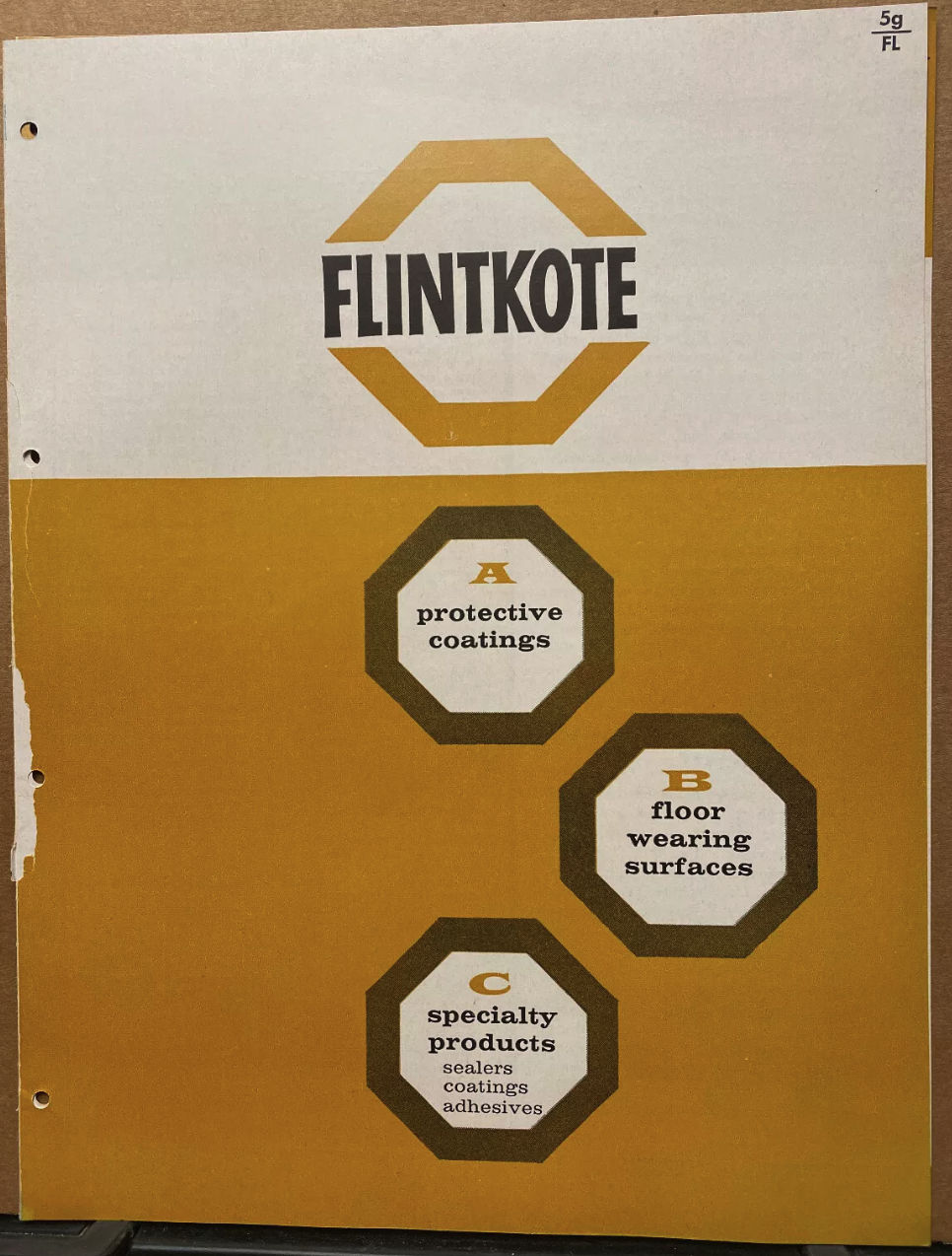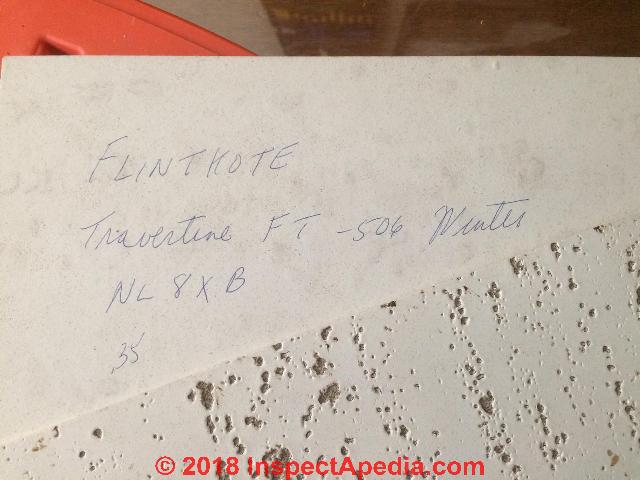 Identify Flintkote Asbestos Products
Identify Flintkote Asbestos Products
Flintkote ceiling tiles, floor tiles, coatings & other materials
- POST a QUESTION or COMMENT about how to identify asbestos-containing materials
How to Identify Floor Tiles & Sheet Flooring That May Contain Asbestos:
This article explains how to identify floor tiles, ceiling tiles and other Flintkote products such as coatings used on boilers, floors, roofs etc. that are likely to contain asbestos.
In many cases we can recognize an asbestos-containing or asbestos-suspect product by making a simple visual inspection, noting the probable age of the building and age of its materials, and similar clues.
Photo at page top: Flintkote Travertine "Winter" ceiling tile, photo courtesy of an InspectApedia reader discussed in the Q&A section on this page.
InspectAPedia tolerates no conflicts of interest. We have no relationship with advertisers, products, or services discussed at this website.
- Daniel Friedman, Publisher/Editor/Author - See WHO ARE WE?
Flintkote Asbestos-containing Floor Tiles & Other Asbestos-products
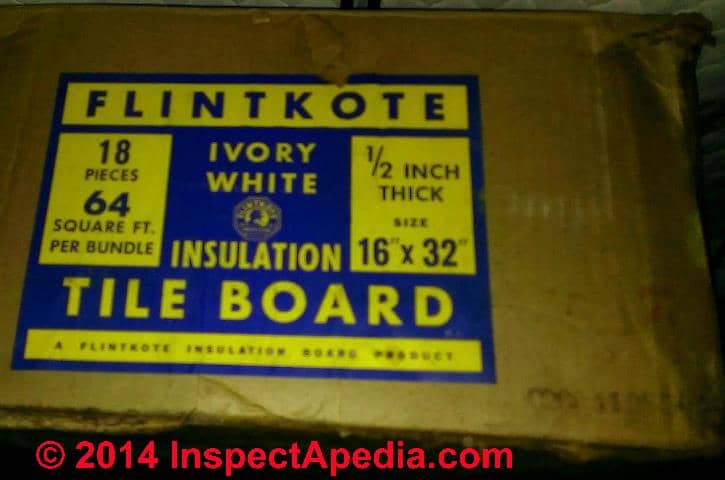 Flintkote Corporation (1940's through at least 1978, some products are listed extending to 1982) produced a number of asbestos-containing materials over its 38-year history, distributing them nationally in the U.S. (and possibly Canada).
Flintkote Corporation (1940's through at least 1978, some products are listed extending to 1982) produced a number of asbestos-containing materials over its 38-year history, distributing them nationally in the U.S. (and possibly Canada).
Flintkote asbestos-containing products were also sold under its affiliate names: Beckman-Dawson Roofing Company and Richardson Roofing.
Photo just above: Flintkote insulating tile board, 1/2" x 16" x 32" - may contain asbestos. Reader contribution.
Illustration: Flintkote ceiling acoustical ceeiling tile box text. Reader contribution found below in the Q&A section.
Products made by Flintkote that contained asbestos, based on the company's on documents (cited below) included at least:
General list of asbestos-containing products produced by the Flintkote Company:
- #229 Antisweat compound, Asbestos Cement Board, Pipe, Sheets, Felt, Joint cement, Asbestos-containing ceiling tiles, Fibrex Cement, Floor Tiles, GF-8 Floor Tile Cement, Joint compound (used on drywall or plasterboard), Plastic cement, Rexalt roof coating, other roof coatings & products, Thermalkote insulating coating, Asbestos tiles, Asbestos-containing "weld-on" cement.
- Asbestos-cement shingles used as building siding, including wood-trained surface textures. Quoting:
- The introduction of asbestos-cement shingles
for siding, in authentic designs duplicating the
textured effects of fine wood shingles, marked
a forward step in the trend towards beauty,
permanence and economy in modern American
home building, Flintkote Asbestos Siding
Shingles give pleasing permanence, plus fire
protection and freedom from costly and periodic painting expense.
- Flintkote Woodgrain Asbestos Sidings, textured like hand-split cedar, are available in
architecturally-correct designs, with staggered,
straight, or wavy lines that give distinctive
shadow effects.
Flintkote Straight Edge Asbes- tos Siding, with a smooth surface and attractive white finish, is another type having popular appeal. Pleasing wall effects can be obtained by combining two types on one house or by using Asbestos Sidings for part of the sidewall in combination with other materials.
All Flintkote Asbestos Siding Shingles are manufactured in relatively large units for greater economy in application.
- Flintkote Asbestos Sidings are the modern
durable sidewall material for new homes or old.
On present homes they can be applied right
over old siding at a cost but slightly higher
than a good paint job. The majority of Flint-
kote Asbestos Siding Shingles are available in
the Sealkote type, especially treated to resist
moisture.
- Asbestos shingles, ... possibly also containing asbestos: built-up roofing, rock wool home insulation,
- Asbestos sidings, ... possibly also containing asbestos: hardboard
- Asphalt sidings, ... possibly also containing asbestos: roll roofings, Therm-O-Seal felt
- and ... possibly also containing asbestos: Asphalt paints & plastics
- Asphalt-brick type siding: For the home owner who desires the substantial
pearance of hand-made brick without its cost, Flintkote
Asphalt Brick-Type and Textured Thikbrik Sidings are
an ideal material.
These durable asphalt sidings pos- sess all the high styling, beautiful coloring, structural advantages and fire resistance of Flintkote Asphalt Shingles.
They are economically applied on new homes or old, never require paint or stain to preserve their life, and cost little more than a good paint job. - Shake Siding: Each exposed edge of Flintkote Woodgrain Shake Siding is unevenly trimmed across the bottom to re-
capture the pleasing irregularity and rugged character
of random width siding shingles used in early Colonial
times.
Waterproof, fire-proof, and requiring no paint or stain to preserve their life, these Flintkote Asbesto* Cement Shake Sidings are becoming increasingly popular, for entire sidewalls or in combination with other Flintkote Asbestos Sidings, on either new homes or old. They cannot rust, rot, corrode or burn. - Straight Edge Siding: [excerpting from text partly lost] ... like all Flintkote Asbestos-Cement Sidings,...
- Waveline Siding: For beautiful texture and distinctive charm, it is diffi-
cult to surpass these Flintkole Woodgrain Waveliw
Asbestos Siding Shingles.
This popular wavy butt line creates a charming informal treatment for your side- walls. Waveline Asbestos-Cement Siding Shingle- at available in two widths, either IOV2 inch or 6 1 /a exposure. You have a preference in the design effect* created when this handsome siding shingle is used. - Wide Space Siding: [excerpting from text partly lost] ... like all Flintkote Asbestos-Cement Sidings,...
- The introduction of asbestos-cement shingles
for siding, in authentic designs duplicating the
textured effects of fine wood shingles, marked
a forward step in the trend towards beauty,
permanence and economy in modern American
home building, Flintkote Asbestos Siding
Shingles give pleasing permanence, plus fire
protection and freedom from costly and periodic painting expense.
- (building products, ceiling tiles, roofing)
- #229 Anti-sweat compound
- Asbestos cement board, asbestos cement sheets, asbestos cement panels, transite panels
- Asbestos cement siding & roofing shingles
- Asbestos cement pipe (transite pipe)
- Asbestos-based felt including flooring underlayment, flashing products,
- Asphalt primer (per 1959 catalog cited below)
- Asphalt road paving emulsions (asbestos content not verified)
- Black (asphaltic) joint cement, trowel-on mastic coatings (catalog page above and text excerpt below)
As you can see in this text snippet from a 1959 Flintkote Catalog, many Flintkote products contained asbestos, particularly the company's mastic coatings and sealants.
- Flintkote C-13 HPC Emulsion - from the 1959 catalog below: "Stable, non-flowing, non-flammable asphalt base clay emulsion without fillers or fibers; also supplied lightly fibrated with asbestos as reinforced coatings C-13C4 and Spraykote."
- Flintkote C-13A Emulsion - from the 1959 catalog below: "Stable asphalt base clay emulsion heavily fibrated with asbestos; applied by trowel; non-flammable and odorless; preferred for coating insulation in cold storage rooms and boiler wall sealing."
- Flintkote Ceiling Tiles
- Flintkote Floor Tiles
Above: note the reference to "floor wearing surfaces" in this
1959 FLINTKOTE CATALOG [PDF] Flintkote Corporation, Industrial Products Division, 20 New York, 30 Rockefeller Plaza; offices also in Chicago Illinois, New Orleans Louisiana, and Los Angeles, California. (original on file at InspectApedia.com)
- Flintkote roofing shingles & other roofing products
- Flintkote Semi-Mastic No. 214 - from the 1959 catalog above: "Moderately fibrated solvent cutback asphalt for brush application; used for dampproofing masonry,coating steel and protecting roofs." [We think that "fibrated" here refers to use of asbestos fibers - Ed.]
- Flintkote Thermalkote - from the 1959 catalog above: "Asphalt base clay emulsion containing high percentage of asbestos fibers to provide thick mastic with good weather resistance. used for trowel application of heavy film over thermal insulation materials, particularly those exposed to weather."
- Flintkote Siding (asbestos-cement shingle siding panels)
- Fibrex cement
- GF-8 floor tile cement (asphalt-asbestos based)
- Gypsum, pipes, paper products (asbestos content not verified)
- Joint compound containing asbestos
- Plastic cement
- Rexalt roof coating
- Siding shingles & panels
- Thermlkote insulating coating
- Vinyl-Asbestos Floor Tiles
- Weld-on cement (dry in cans, and pre-mixed)
- Other products, probably non-asbestos-containing: folding boxes & packaging for consumer goods 1940->?, stone products, pipe products, packaging materials produced in the U.S. and Canada.
Research on Asbestos in Flintkote Products & Flintkote History
Shown here: an advertisement for Flintkote 12" Ceiling Tiles, Aquatone, Circles, Ribbon, and Pebbletex Acoustical Ceiling tiles, appearing on page 8 of the Winona Daily News, 11/11/1964, retrieved 2021/02/07 original source: https://openriver.winona.edu/cgi/viewcontent.cgi?article=1520&context=winonadailynews
Flintkote, Founded in 1901, incorporated in 1917, stopped producing asbestos-containing products in 1982 and stopped distributing asbestos-containing products in 1984. Flintkote was owned, indirectly, by this parent company: Imperial Tobacco Canada, Ltd., between 1986 and 2003.
Flintkote ceased all operations in 1987 when it sold its construction, stone, and cement manufacturing facilities.
Flintkote and Flintkote Mines filed for Chapter 11 bankruptcy on 1 May 2004, and entered into an amended joint plan of reorganization on 30 September 2015.
- CANADIAN BUILDING PRODUCTS of 1967 [PDF] retrieved 2021/02/07 original source: http://publications.gc.ca/collections/collection_2020/isde-ised/Id44-10-1966.pdf
Lists Floor Coverings by Flintkote Company of Canada, Ltd., Toronto, Ontario, sold in Canada in 1967 - see page. 40. - Debtor’s Fourth Motion For An Order Pursuant To 11 U.S.C. § 1121(d) Extending Debtors’ Exclusive Periods In Which To File A Chapter 11 Plan And To Solicit Votes Th ereon, Dkt. No. 981, pp. 3-4, In re Th e Flintkote Co., No. 04-11300 (JKF) (Bankr. D. Del. July 25, 2005).
- FLINTKOTE BUILDING MATERIALS [PDF] includes identification of asbestos-containing products, original source: https://archive.org/stream/FlintkoteCo./FlintkoteCo._djvu.txt
- Flintkote, "Helpful Facts for Home Builders", Flintkote Company, 50 West 50th St., New York NY, with additional offices in New Orleans LA, Waco Texas, Chicago Heights IL, Atalanta Georga, and Los Angeles CA, retrieved 8/30/2014, original source: https://archive.org/stream/FlintkoteCo./FlintkoteCo._djvu.txt, copy on file
- The Flintkote asbestos settlement trust is discussed separately in ASBESTOS PRODUCING COMPANIES & TRUSTS - in that documet
see FLINKOTE ASBESTOS SETTLEMENT TRUST
- Manderbach, James R., and Pestel Paul. "Fire-resistant wall construction." U.S. Patent 3,418,776, issued December 31, 1968.
Excerpt:
One object of the invention is to provide a Wall construction of the indicated type having a high degree of resistance to re. In wall constructions in general use today the `joints between the wallboard panels are sealed with tapes of paper, cloth, asbestos and appropriate cementation compounds or they are covered with moulding or reinforced on the back of the wallboard with strips of gypsum laminated in a position to bridge the joint. - Morris, Klimboff. "Bituminous roofing and siding material coated with exfoliated vermiculite." U.S. Patent 3,207,619, issued September 21, 1965.
Excerpt:
For many years vast quantities of roofing have been sold generally composed of a foundation layer or base which is usually a felted fibrous layer made up of paper and/or rag and/or asbestos fiber.
The felt is usually saturated with a water-proofing substance such as bituminous composition, for instance, a low melting point bitumen. The felt is usually coated on one or both of its faces with a higher melting point bitumen.
While the bitumen is still in a plastic state granules are ordinarily pressed therein on the weather exposed face to protect the bitumen from the ultra violet rays or actinic of the sun as well as to form a decorative coating. The bitumen coating would otherwise deteriorate producing cracking or crazing, thus permitting leaking on the roof in due time.
...
I have discovered, quite by accident, that a roof covering or shingle having advantages over those presently used can be made by employing granules whose properties are in most respects the opposite of those which have been usually considered desirable in the past.
Rather than being rock like, it is soft enough so that it can be compressed to a noticeable degree by the fingers. Rather 3,207,619 Patented Sept. 21, 1965 than having a low water absorption, it will absorb water in large amounts, and it is unnecessary to treat the material specially in order to reduce water absorption. It is also flaky and friable material.
Apparently, because of these properties, it has never been suggested for use as a roofing granule even though it is a material which is in wide use in the building material industry.
Nevertheless, I have now established that a roof covering comprising my new granules will have the following advantages over those now being marketed in large quantities - Plevin
, Mark D., Paul W. Kalish
And
Leslie A. Epley , WhWHERE ARE THEY NOW, Part Three: A Continuing History Of The Companies That Have Sought Bankruptcy Protection Due To Asbestos Claims [PDF] Mealey's Asbestos Report, Vol. 5, #4 November 2000 - retrieved 2023/04/08, original source: crowell.com/pdf/WhereAreTheyNowPart3.pdf
Excerpt: Flintkote. An old veteran of the asbestos wars, Flintkote Co., filed a Chapter 11 bankruptcy on May 1, 2004, in the U.S. Bankruptcy Court for the District of Delaware.48
An affiliate, Flintkote Mines, filed a related Chapter 11 case on August 25, 2004. 49
Flintkote has not conducted operations, other than paying asbestos claims and litigating insurance issues, since approximately 1987.50
Flintkote asserted that more than 155,000 asbestos claims were pending against it as of the petition date.51
As of this writing, Flintkote has not filed any plan of reorganization, although it has indicated that it intends to invoke the provisions of § 524(g). 52 - Woods, Amy Lamb, KEEPING A LID ON IT: ASBESTOS-CEMENT BUILDING MATERIALS [PDF] (2000) Original source> cr.nps.gov/hps/tps/recentpast/asbestosarticle.htm – Dead Link.
Excerpt:
Flintkote Company, engaged in producing a wide range of asbestos-cement products throughout much of the first half of the century.
Note that some Vermiculite contains asbestos.
This document assists building buyers, owners or inspectors who need to identify asbestos materials (or probable-asbestos) in buildings by visual inspection.
...
Reader Comments, Questions & Answers About The Article Above
Below you will find questions and answers previously posted on this page at its page bottom reader comment box.
Reader Q&A - also see RECOMMENDED ARTICLES & FAQs
Do these Flintkote Pebblestone ceiling tiles contain asbestos?
 Do you know if these particular ceiling tiles contain asbestos? - On 2021-02-07
by Cory Hedrick -
Do you know if these particular ceiling tiles contain asbestos? - On 2021-02-07
by Cory Hedrick -
Reply by (mod) - Flintkote produced some Asbestos-containing ceiling tiles up to 1982, distributed up to 1984
Cory:
I don't know for sure. Certainly it is reported that Flintkote did produce some Asbestos-containing ceiling tiles.
It would be helpful if we could find a data tag or stamp or any data allowing a reasonable guess at the age of those FlintKote 80A Pebbletex ceiling tiles.
That's because FlintKote stopped using asbestos in their products in 1982, and stopped distributing (presumably old stock) products that contained asbestos by some time in 1984.
Arguing against asbestos is the product's "Class D" rating - not a fire resistant product at least by current meaning of fire class ratings (Class A is fire resistant).
Arguing caution: Flintkote 12" Pebblestone ceiling tiles were sold at least as early as 1964, well before the company stopped using asbestos in its products.
More ideas on making a good guess are at DO THESE CEILING TILES CONTAIN ASBESTOS? - 5 Easy Steps to tell if CEILING TILES are likely to contain asbestos
Where we're left is that to be prudent and safe you should treat the ceiling tiles as "PACM" - Presumed Asbestos-Containing Material. That means avoid making a dusty mess with the material.
On 2019-04-09 by (mod) - Properties of Flintcote 3 from abe-Construction
Flintcote 3 from ABE-Construction is a black waterproofing coating used on conctete, steel, and other surfaces a ... "Thixotropic water dispersed bitumen emulsion." Here is an excerpt from abe-construction's instructions for using Flintcote 3 -
BONDING/PRIMING
Dilute 1:1 with water for porous surfaces. Use bitu.®prime
on steel.
MIXING
Stir flintkote 3 well before use, using a flat paddle.
COVERAGE
1,25 m²/L as coating; 7L/m² as binder.
APPLICATION
flintkote 3 is normally applied by brush and generally
should not be applied thicker than specified. A coat should
be thoroughly dry before application of a second coat. This
can be easily determined by rubbing the surface with a wet
finger.
If the finger remains clean, the surface is dry enough
to overcoat. flintkote 3 can be used in conjunction with
a glass fibre membrane to build up and reinforce thicker
coats.
The membrane must be set into the still wet film of
flintkote 3 and ideally all bubbles and wrinkles should be
removed by means of a laminating roller.
The film is allowed to dry and then a second coat is applied
at a sufficient thickness to completely obliterate the weave
and pattern of the membrane.
Where the flintkote 3 film
is finally to be exposed to the effects of sunlight and ultraviolet radiation, it is recommended that, some 3 - 4 weeks
after being applied, it be overcoated with silvakote.
CLEANING
Ordinary clean water or abe® super brush cleaner.
PROTECTION ON COMPLETION
Protect against traffic and spillage until cured. If exposed to
direct extensive sunlight, overcoat with abe® silvakote.
TEMPERATURE AND RELATIVE HUMIDITY
High humidity slows evaporation of water dispersant.
- original source: a.b.e.® is an ISO 9001:2008 registered company
PO Box 5100, Boksburg North, 1461, South AfricaWebsite: www.abe.co.za | Tel: +27(0) 11 306 9000Durban | Johannesburg | Cape Town | Port Elizabeth | East London | Bloemfontein | George
I have a tin of Flintcote 3 product. Can you tell me what this is used for and how
I have a tin of Flintcote 3 product. Can you tell me what this is used for and how On 2019-04-09 by Annis van Greenen -
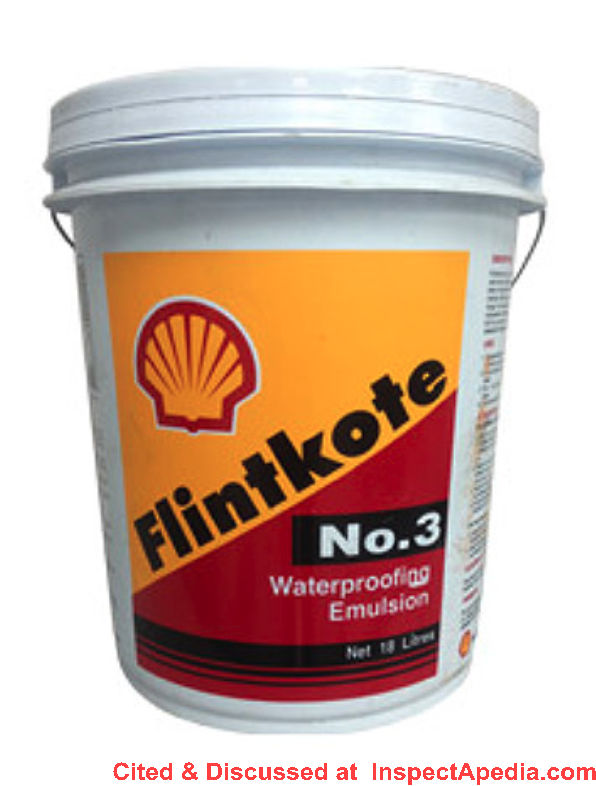
Reply by Mod: maybe, depending on product manufacturer, country, location, age
Filntcote 3 was and is today a waterproofing sealant, a bitumen emulsion that is applied by spray, brush, or trowel, currently produced by the Shell Oil Company - illustrated above. We would not expect to find asbestos in the modern product.
However asbestos fibers were frequently used in older asphaltic or bituminous roof sealants, flashing cements and coatings.
So our answer to your asbestos in Flintkote question is ... it depends - on when your product was made.
On 2018-09-18 by John H Could these Flintkote 12x12 ceiling tiles NOT contain Asbestos?
Hi there--found a stack of nice-looking 12" x 12" vinyl-composite tiles with these markings on them--FLINTKOTE Travertine -506 Winter NL 8 x B. Any chance they DON'T contain asbestos? They're certainly not friable or crushable. I'm inclined to use them in a small fooring project.
Reply by DF: Flintkote flooring asbestos and history
Thanks for the photo and question, John.
As Flinkote ceased operations in 1987, stopped using asbestos in their products in 1982, and stopped distributing (presumably old stock) products that contained asbestos by some time in 1984, we have a modest chance that your floor tiles do not contain asbestos, PROVIDED that they were manufactured by Flintkote after 1982.
On 2018-12-10 by mike Asbestos in Flintkote Crevatex ceiling tiles?
Does Flintkote Crevatex ceiling tile contain asbestos
Reply by (mod) - Many Flintkote Coatings and Sealants Contained Asbestos
I would treat the ceiling tile as presumed to contain asbestos, or have a sample tested.
...
Continue reading at ASBESTOS FLOORING IDENTIFICATION or select a topic from the closely-related articles below, or see the complete ARTICLE INDEX.
Recommended Articles
- ASBESTOS CEILING TILE IDENTIFICATION
- ASBESTOS DISPOSAL REGULATIONS
- ASBESTOS FLOOR TILE COMPOSITION
- ASBESTOS FLOORING DAMAGE HAZARDS
- ASBESTOS FLOORING HAZARD LEVEL ASSESSMENT
- ASBESTOS FLOORING HAZARD REDUCTION
- ASBESTOS FLOOR TILE IDENTIFICATION COLOR KEY - home
- ASBESTOS FLOORING IDENTIFICATION GUIDE INDEX - all brands, all years
- ASBESTOS FLOORING REMOVAL GUIDE
- ASBESTOS REMOVAL, WETTING GUIDELINES
- ASBESTOS RISK ASSESSMENT
- ASBESTOS TESTING LAB LIST
- ASBESTOS CEILING TILE IDENTIFICATION - 5 Easy Steps to tell if CEILING TILES are likely to contain asbestos
- DOES THIS FLOOR CONTAIN ASBESTOS? - 5 easy questions to tell if your FLOOR probably contains asbestos -
- DOES THIS MATERIAL CONTAIN ASBESTOS? - 5 easy questions to tell if a BUILDING MATERIAL probably contains asbestos -
- FLINTKOTE Stalwart™ SHEATHING ASBESTOS - plant based insulating sheathing is not an asbestos product
- MARBLE / STONE CHIP PATTERN FLOORING ASBESTOS
- RESILIENT SHEET FLOORING ID GUIDE
Suggested citation for this web page
FLINTKOTE ASBESTOS PRODUCTS GUIDE at InspectApedia.com - online encyclopedia of building & environmental inspection, testing, diagnosis, repair, & problem prevention advice.
Or see this
INDEX to RELATED ARTICLES: ARTICLE INDEX to ASBESTOS HAZARDS
Or use the SEARCH BOX found below to Ask a Question or Search InspectApedia
Ask a Question or Search InspectApedia
Try the search box just below, or if you prefer, post a question or comment in the Comments box below and we will respond promptly.
Search the InspectApedia website
Note: appearance of your Comment below may be delayed: if your comment contains an image, photograph, web link, or text that looks to the software as if it might be a web link, your posting will appear after it has been approved by a moderator. Apologies for the delay.
Only one image can be added per comment but you can post as many comments, and therefore images, as you like.
You will not receive a notification when a response to your question has been posted.
Please bookmark this page to make it easy for you to check back for our response.
IF above you see "Comment Form is loading comments..." then COMMENT BOX - countable.ca / bawkbox.com IS NOT WORKING.
In any case you are welcome to send an email directly to us at InspectApedia.com at editor@inspectApedia.com
We'll reply to you directly. Please help us help you by noting, in your email, the URL of the InspectApedia page where you wanted to comment.
Citations & References
In addition to any citations in the article above, a full list is available on request.
- Asbestos Floor Tile Removal Guide & Instructions [web page] Minnesota Department of Health, copy on file as Asbestos_Floor_Tile_Removal_MDH.pdf - retrieved 2024/08/08, original retrieved 12/7/2010, original source: http://www.health.state.mn.us/divs/eh/asbestos/floortile/index.html (original dead link in 2024 - Ed.)
Excerpt:
Flooring that contains asbestos, when intact and in good condition, is not considered hazardous.
However, heat, water, or aging can damage flooring to the point where it is friable. Friable means the flooring can be crumbled with hand pressure. Flooring can also be made friable during removal. Friable flooring can release asbestos into the air. Once in the air, asbestos is a health hazard when people breathe it.
- MANAGING ASBESTOS in PLACE: A Building Owner's Guide to Operations and Maintenance Programs for Asbestos-Containing Materials ("Green Book"), web search 08/11/2010, original source: http://www.epa.gov/asbestos/pubs/management_in_place.html
How to Develop and Maintain a Building Asbestos Operations and Maintenance (O&M) Program, This information is designed to assist building owners and managers in understanding how to develop and maintain an operations and maintenance program for asbestos-containing materials in their buildings. - Monitoring Asbestos-Containing Material (ACM), U.S. EPA, web search 08/11/2010, original source: http://www.epa.gov/asbestos/pubs/section6.html, quoting:
Periodic Visual Reinspections and Air Monitoring
A visual reinspection of all ACM should be conducted at regular intervals as part of the O&M program to help ensure that any ACM damage or deterioration will be detected and corrective action taken.
Supplemental Air Monitoring:
As part of an O&M program, a carefully designed air monitoring program to detect airborne asbestos fibers in the building may provide useful supplemental information when conducted along with a comprehensive visual and physical ACM inspection and reinspection program. For employees who are, or may reasonably be expected to be exposed to airborne concentrations of asbestos fibers above the permissible limits set by the Occupational Safety and Health Administration (OSHA), regulations require that the employer conduct both initial and periodic air sampling. For more information about the OSHA exposure monitoring requirements, see the regulations at 29 CFR § 1910.1001(d).
Selecting a Lab
Selection of a reliable and experienced air monitoring firm and analytical laboratory is important, if the building owner elects to conduct supplemental air monitoring under the O&M program. A consultant knowledgeable in air sampling and analysis protocols can be contacted for recommendations if the building owner or APM has limited knowledge in this area. Contact your state asbestos regulatory agency (5 pp, 17k, PDF) for information on how to find an accredited asbestos professional. In addition, the National Institute for Standards and Technology (NIST) maintains a listing of accredited asbestos laboratories under the National Voluntary Laboratory Accreditation Program (NVLAP). You may call NIST at (301) 975-4016. - "Handling Asbestos-Containing roofing material - an update", Carl Good, NRCA Associate Executive Director, Professional Roofing, February 1992, p. 38-43
- EPA Guidance for Controlling Asbestos-Containing Materials in buildings, NIAST, National Institute on Abatement Sciences & Technology, [republishing EPA public documents] 1985 ed., Exposure Evaluation Division, Office of Toxic Substances, Office of Pesticides and Toxic Substances, U.S. Environmental Protection Agency, Washington,D.C. 20460
- In addition to citations & references found in this article, see the research citations given at the end of the related articles found at our suggested
CONTINUE READING or RECOMMENDED ARTICLES. - Our recommended books about building & mechanical systems design, inspection, problem diagnosis, and repair, and about indoor environment and IAQ testing, diagnosis, and cleanup are at the InspectAPedia Bookstore.
Also see our Book Reviews - InspectAPedia. - In addition to citations & references found in this article, see the research citations given at the end of the related articles found at our suggested
CONTINUE READING or RECOMMENDED ARTICLES.
- Carson, Dunlop & Associates Ltd., 120 Carlton Street Suite 407, Toronto ON M5A 4K2. Tel: (416) 964-9415 1-800-268-7070 Email: info@carsondunlop.com. Alan Carson is a past president of ASHI, the American Society of Home Inspectors.
Thanks to Alan Carson and Bob Dunlop, for permission for InspectAPedia to use text excerpts from The HOME REFERENCE BOOK - the Encyclopedia of Homes and to use illustrations from The ILLUSTRATED HOME .
Carson Dunlop Associates provides extensive home inspection education and report writing material. In gratitude we provide links to tsome Carson Dunlop Associates products and services.


